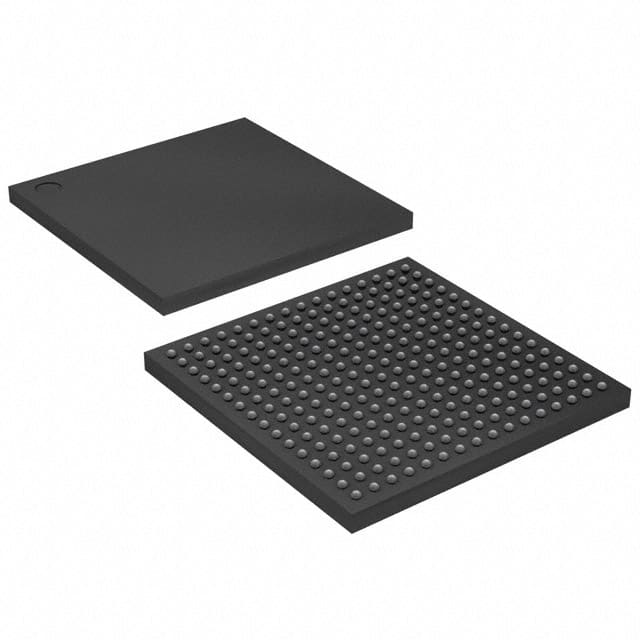Xem thông số kỹ thuật để biết chi tiết sản phẩm.

XCV100E-7FG256C
Product Overview
Category
The XCV100E-7FG256C belongs to the category of Field Programmable Gate Arrays (FPGAs).
Use
FPGAs are integrated circuits that can be programmed and reprogrammed to perform various digital functions. The XCV100E-7FG256C is specifically designed for applications requiring high-performance logic and digital signal processing.
Characteristics
- High-performance FPGA with advanced features
- Flexible and reprogrammable design
- Suitable for complex digital designs
- Offers a wide range of I/O options
- Low power consumption
- Reliable and durable construction
Package
The XCV100E-7FG256C comes in a 256-pin Fine-Pitch Ball Grid Array (FBGA) package.
Essence
The essence of the XCV100E-7FG256C lies in its ability to provide a versatile and customizable solution for digital circuit design, offering high performance and flexibility.
Packaging/Quantity
The XCV100E-7FG256C is typically packaged individually and is available in various quantities depending on the customer's requirements.
Specifications
- Logic Cells: 100,000
- System Gates: 50,000
- Block RAM: 2,560 bits
- Maximum Frequency: 250 MHz
- I/O Pins: 256
- Operating Voltage: 1.8V
- Operating Temperature: -40°C to 100°C
Detailed Pin Configuration
The XCV100E-7FG256C has a total of 256 pins, each serving a specific purpose in the overall functionality of the FPGA. For a detailed pin configuration diagram, please refer to the manufacturer's datasheet.
Functional Features
- High-speed data processing capabilities
- Configurable logic blocks for custom circuit implementation
- Dedicated digital signal processing (DSP) slices
- On-chip memory resources for efficient data storage
- Built-in clock management resources for precise timing control
- Various I/O standards and interfaces for seamless integration with external devices
Advantages and Disadvantages
Advantages
- Flexibility in design and reconfiguration
- High-performance computing capabilities
- Low power consumption compared to traditional ASICs
- Shorter development cycles due to programmability
- Cost-effective solution for prototyping and low-volume production
Disadvantages
- Limited scalability compared to custom-designed ASICs
- Higher cost per unit compared to mass-produced ASICs
- Increased complexity in programming and debugging
Working Principles
The XCV100E-7FG256C operates based on the principles of digital logic. It consists of configurable logic blocks, interconnect resources, and dedicated functional units. The FPGA can be programmed using a Hardware Description Language (HDL) to define the desired circuit functionality. Upon configuration, the FPGA executes the programmed logic, enabling the desired digital operations.
Detailed Application Field Plans
The XCV100E-7FG256C finds applications in various fields, including:
- Telecommunications: Used in base stations, network routers, and communication equipment for high-speed data processing.
- Industrial Automation: Employed in control systems, robotics, and machine vision applications for real-time data processing and control.
- Aerospace and Defense: Utilized in radar systems, avionics, and military-grade electronics for high-performance computing and signal processing.
- Medical Devices: Integrated into medical imaging systems, patient monitoring devices, and diagnostic equipment for advanced data processing and analysis.
- Automotive: Applied in advanced driver-assistance systems (ADAS), infotainment systems, and engine control units for enhanced performance and functionality.
Detailed and Complete Alternative Models
- XCV200E-7FG256C: A higher-capacity FPGA with 200,000 logic cells and extended functionality.
- XCV50E-7FG256C: A lower-capacity FPGA suitable for smaller-scale applications with reduced power consumption.
- XCV400E-7FG676C: A larger FPGA with 400,000 logic cells and enhanced I/O capabilities for complex designs.
These alternative models offer varying capacities and features to cater to different application requirements.
In conclusion, the XCV100E-7FG256C is a high-performance FPGA that provides flexibility, versatility, and advanced digital processing capabilities. With its configurable logic blocks, extensive I/O options, and reliable construction, it serves as a valuable solution in various industries, including telecommunications, industrial automation, aerospace, medical devices, and automotive applications.
Liệt kê 10 câu hỏi và câu trả lời thường gặp liên quan đến ứng dụng XCV100E-7FG256C trong giải pháp kỹ thuật
Sure! Here are 10 common questions and answers related to the application of XCV100E-7FG256C in technical solutions:
Q: What is the XCV100E-7FG256C? A: The XCV100E-7FG256C is a field-programmable gate array (FPGA) manufactured by Xilinx.
Q: What are the key features of the XCV100E-7FG256C? A: The XCV100E-7FG256C offers 100,000 system gates, 5,760 logic cells, 64 I/O pins, and operates at a maximum frequency of 200 MHz.
Q: What are some typical applications of the XCV100E-7FG256C? A: The XCV100E-7FG256C is commonly used in digital signal processing, industrial automation, telecommunications, and automotive electronics.
Q: How can I program the XCV100E-7FG256C? A: The XCV100E-7FG256C can be programmed using Xilinx's Vivado Design Suite or ISE Design Suite software tools.
Q: What is the power supply requirement for the XCV100E-7FG256C? A: The XCV100E-7FG256C requires a single 3.3V power supply for operation.
Q: Can I interface the XCV100E-7FG256C with other devices? A: Yes, the XCV100E-7FG256C supports various communication protocols such as SPI, I2C, UART, and Ethernet, allowing it to interface with other devices.
Q: Does the XCV100E-7FG256C have any built-in security features? A: Yes, the XCV100E-7FG256C provides built-in AES encryption and tamper detection capabilities to enhance system security.
Q: What is the maximum operating temperature of the XCV100E-7FG256C? A: The XCV100E-7FG256C can operate within a temperature range of -40°C to 100°C.
Q: Can I use the XCV100E-7FG256C in high-reliability applications? A: Yes, the XCV100E-7FG256C is designed to meet stringent quality and reliability standards, making it suitable for high-reliability applications.
Q: Where can I find more information about the XCV100E-7FG256C? A: You can refer to the Xilinx website or consult the XCV100E-7FG256C datasheet for detailed technical information and application notes.

